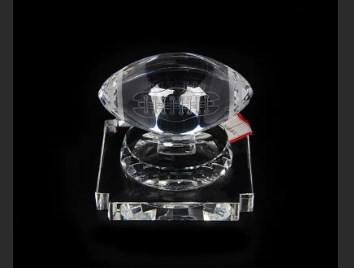The creation of a glass globe trophy is a process that combines artistry, craftsmanship, and precision engineering. These trophies, often used to honor achievements and milestones, are not just simple glass objects; they are works of art that require a series of meticulous steps to bring them to life. The journey of a glass globe trophy from concept to completion is a testament to the skill and dedication of the artisans involved.
The process begins with the design and conceptualization of the glass globe trophy. Designers sketch out the desired shape, size, and any specific features such as engravings or color gradients. This stage is crucial as it sets the foundation for the entire production process. The design must be both aesthetically pleasing and structurally sound to withstand the rigors of the glassblowing process.
Once the design is finalized, a mold is created. This mold is typically made from a heat-resistant material that can withstand the high temperatures of the glassblowing process. The mold is carefully crafted to match the design specifications, ensuring that the final product will have the desired shape and details.
The next step is the melting of the glass. High-quality raw materials, such as silica sand, soda ash, and limestone, are heated in a furnace to temperatures exceeding 1700 degrees Celsius. This process transforms the raw materials into a molten state, ready to be shaped into the glass globe trophy.
The molten glass is then carefully transferred to the artisan, who begins the process of blowing and shaping the glass. Using a blowpipe, the artisan inflates the glass into the mold, carefully controlling the shape and thickness of the glass. This step requires immense skill and experience to ensure that the glass is evenly distributed and free of bubbles or imperfections.
After the glass has been shaped, it is allowed to cool slowly. This cooling process, known as annealing, is critical to the strength and durability of the glass globe trophy. Rapid cooling can cause the glass to crack or shatter due to internal stress. By controlling the cooling rate, artisans ensure that the glass is strong and resilient.
Once the glass has cooled and solidified, it is removed from the mold and undergoes a series of finishing processes. This may include grinding and polishing to achieve a smooth, reflective surface. Any additional features, such as engravings or color applications, are added at this stage. The polishing process is meticulous, ensuring that the glass globe trophy has a high-quality, professional finish.
Before the glass globe trophy is deemed ready for distribution, it undergoes a rigorous quality control process. Each trophy is inspected for any defects, ensuring that it meets the high standards of craftsmanship and quality. This inspection process is crucial in maintaining the reputation of the manufacturer and ensuring customer satisfaction.
The final step in the production process is the packaging and distribution of the glass globe trophy. Each trophy is carefully packaged to protect it during transit and is then shipped to the customer or event organizer. The packaging must be both secure and visually appealing, reflecting the prestige associated with the glass globe trophy.
In conclusion, the production of a glass globe trophy is a complex and intricate process that requires a combination of artistic vision, technical skill, and attention to detail. From the initial design to the final packaging, each step is carefully executed to create a trophy that is not only a symbol of achievement but also a work of art that can be cherished for years to come.
